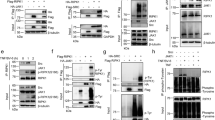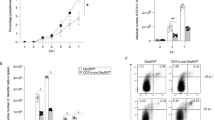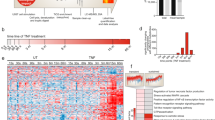Abstract
The transcription factor Miz1 negatively regulates TNF-induced JNK activation and cell death by suppressing TRAF2 K63-polyubiquitination; upon TNF stimulation, the suppression is relieved by Mule/ARF-BP1-mediated Miz1 ubiquitination and subsequent degradation. It is not known how Mule is activated by TNF. Here we report that TNF activates Mule by inducing the dissociation of Mule from its inhibitor ARF. ARF binds to and thereby inhibits the E3 ligase activity of Mule in the steady state. TNF induces tyrosine phosphorylation of Mule, which subsequently dissociates from ARF and becomes activated. Inhibition of Mule phosphorylation by silencing of the Spleen Tyrosine Kinase (Syk) prevents its dissociation from ARF, thereby inhibiting Mule E3 ligase activity and TNF-induced JNK activation and cell death. Our data provides a missing link in TNF signaling pathway that leads to JNK activation and cell death.
This is a preview of subscription content, access via your institution
Access options
Subscribe to this journal
Receive 50 print issues and online access
$259.00 per year
only $5.18 per issue
Buy this article
- Purchase on SpringerLink
- Instant access to full article PDF
Prices may be subject to local taxes which are calculated during checkout







Similar content being viewed by others
References
Tartaglia LA, Goeddel DV . Two TNF receptors. Immunol Today 1992; 13: 151–153.
Tracey KJ, Cerami A . Tumor necrosis factor: a pleiotropic cytokine and therapeutic target. Annu Rev Med 1994; 45: 491–503.
Ashkenazi A, Dixit VM . Death receptors: signaling and modulation. Science 1998; 281: 1305–1308.
Hibi M, Lin A, Smeal T, Minden A, Karin M . Identification of an oncoprotein- and UV-responsive protein kinase that binds and potentiates the c-Jun activation domain. Genes Dev 1993; 7: 2135–2148.
Kyriakis JM, Banerjee P, Nikolakaki E, Dai T, Rubie EA, Ahmad MF et al. The stress-activated protein kinase subfamily of c-Jun kinases. Nature 1994; 369: 156–160.
Liu Y, Guyton KZ, Gorospe M, Xu Q, Lee JC, Holbrook NJ . Differential activation of ERK, JNK/SAPK and P38/CSBP/RK map kinase family members during the cellular response to arsenite. Free Radic Biol Med 1996; 21: 771–781.
Tada K, Okazaki T, Sakon S, Kobarai T, Kurosawa K, Yamaoka S et al. Critical roles of TRAF2 and TRAF5 in tumor necrosis factor-induced NF-kappa B activation and protection from cell death. J Biol Chem 2001; 276: 36530–36534.
Yeh KW, Chen JC, Lin MI, Chen YM, Lin CY . Functional activity of sporamin from sweet potato (Ipomoea batatas Lam.): a tuber storage protein with trypsin inhibitory activity. Plant Mol Biol 1997; 33: 565–570.
Liu ZG, Hsu H, Goeddel DV, Karin M . Dissection of TNF receptor 1 effector functions: JNK activation is not linked to apoptosis while NF-kappaB activation prevents cell death. Cell 1996; 87: 565–576.
Micheau O, Tschopp J . Induction of TNF receptor I-mediated apoptosis via two sequential signaling complexes. Cell 2003; 114: 181–190.
Yeh WC, Shahinian A, Speiser D, Kraunus J, Billia F, Wakeham A et al. Early lethality, functional NF-kappaB activation, and increased sensitivity to TNF-induced cell death in TRAF2-deficient mice. Immunity 1997; 7: 715–725.
Takada Y, Aggarwal BB . TNF activates Syk protein tyrosine kinase leading to TNF-induced MAPK activation, NF-kappaB activation, and apoptosis. J Immunol 2004; 173: 1066–1077.
Mocsai A, Abram CL, Jakus Z, Hu Y, Lanier LL, Lowell CA . Integrin signaling in neutrophils and macrophages uses adaptors containing immunoreceptor tyrosine-based activation motifs. Nat Immunol 2006; 7: 1326–1333.
Mocsai A, Humphrey MB, Van Ziffle JA, Hu Y, Burghardt A, Spusta SC et al. The immunomodulatory adapter proteins DAP12 and Fc receptor gamma-chain (FcRgamma) regulate development of functional osteoclasts through the Syk tyrosine kinase. Proc Natl Acad Sci USA 2004; 101: 6158–6163.
Mocsai A, Zhou M, Meng F, Tybulewicz VL, Lowell CA . Syk is required for integrin signaling in neutrophils. Immunity 2002; 16: 547–558.
Obergfell A, Eto K, Mocsai A, Buensuceso C, Moores SL, Brugge JS et al. Coordinate interactions of Csk, Src, and Syk kinases with [alpha]IIb[beta]3 initiate integrin signaling to the cytoskeleton. J Cell Biol 2002; 157: 265–275.
Poole A, Gibbins JM, Turner M, van Vugt MJ, van de Winkel JG, Saito T et al. The Fc receptor gamma-chain and the tyrosine kinase Syk are essential for activation of mouse platelets by collagen. EMBO J 1997; 16: 2333–2341.
Vines CM, Potter JW, Xu Y, Geahlen RL, Costello PS, Tybulewicz VL et al. Inhibition of beta 2 integrin receptor and Syk kinase signaling in monocytes by the Src family kinase Fgr. Immunity 2001; 15: 507–519.
Chen D, Kon N, Li M, Zhang W, Qin J, Gu W . ARF-BP1/Mule is a critical mediator of the ARF tumor suppressor. Cell 2005; 121: 1071–1083.
Adhikary S, Marinoni F, Hock A, Hulleman E, Popov N, Beier R et al. The ubiquitin ligase HectH9 regulates transcriptional activation by Myc and is essential for tumor cell proliferation. Cell 2005; 123: 409–421.
Hall JR, Kow E, Nevis KR, Lu CK, Luce KS, Zhong Q et al. Cdc6 stability is regulated by the Huwe1 ubiquitin ligase after DNA damage. Mol Biol Cell 2007; 18: 3340–3350.
Herold S, Hock A, Herkert B, Berns K, Mullenders J, Beijersbergen R et al. Miz1 and HectH9 regulate the stability of the checkpoint protein, TopBP1. EMBO J 2008; 27: 2851–2861.
Liu Z, Oughtred R, Wing SS . Characterization of E3Histone, a novel testis ubiquitin protein ligase which ubiquitinates histones. Mol Cell Biol 2005; 25: 2819–2831.
Noy T, Suad O, Taglicht D, Ciechanover A . HUWE1 ubiquitinates MyoD and targets it for proteasomal degradation. Biochem Biophys Res Commun 2012; 418: 408–413.
Parsons JL, Tait PS, Finch D, Dianova II, Edelmann MJ, Khoronenkova SV et al. Ubiquitin ligase ARF-BP1/Mule modulates base excision repair. EMBO J 2009; 28: 3207–3215.
Yang Y, Do H, Tian X, Zhang C, Liu X, Dada LA et al. E3 ubiquitin ligase Mule ubiquitinates Miz1 and is required for TNFalpha-induced JNK activation. Proc Natl Acad Sci USA 2010; 107: 13444–13449.
Zhong Q, Gao W, Du F, Wang X . Mule/ARF-BP1, a BH3-only E3 ubiquitin ligase, catalyzes the polyubiquitination of Mcl-1 and regulates apoptosis. Cell 2005; 121: 1085–1095.
Kosan C, Saba I, Godmann M, Herold S, Herkert B, Eilers M et al. Transcription factor miz-1 is required to regulate interleukin-7 receptor signaling at early commitment stages of B cell differentiation. Immunity 2010; 33: 917–928.
Peukert K, Staller P, Schneider A, Carmichael G, Hanel F, Eilers M . An alternative pathway for gene regulation by Myc. EMBO J 1997; 16: 5672–5686.
Wanzel M, Kleine-Kohlbrecher D, Herold S, Hock A, Berns K, Park J et al. Akt and 14-3-3eta regulate Miz1 to control cell-cycle arrest after DNA damage. Nat Cell Biol 2005; 7: 30–41.
Do-Umehara HC, Chen C, Urich D, Zhou L, Qiu J, Jang S et al. Suppression of inflammation and acute lung injury by Miz1 via repression of C/EBP-delta. Nat Immunol 2013; 14: 461–469.
Liu J, Zhao Y, Eilers M, Lin A, Herold S, Hock A et al. Miz1 is a signal- and pathway-specific modulator or regulator (SMOR) that suppresses TNF-alpha-induced JNK1 activation. Proc Natl Acad Sci USA 2009; 106: 18279–18284.
Itahana K, Bhat KP, Jin A, Itahana Y, Hawke D, Kobayashi R et al. Tumor suppressor ARF degrades B23, a nucleolar protein involved in ribosome biogenesis and cell proliferation. Mol Cell 2003; 12: 1151–1164.
Bertwistle D, Sugimoto M, Sherr CJ . Physical and functional interactions of the Arf tumor suppressor protein with nucleophosmin/B23. Mol Cell Biol 2004; 24: 985–996.
de Stanchina E, McCurrach ME, Zindy F, Shieh SY, Ferbeyre G, Samuelson AV et al. E1A signaling to p53 involves the p19(ARF) tumor suppressor. Genes Dev 1998; 12: 2434–2442.
Khan SH, Moritsugu J, Wahl GM . Differential requirement for p19ARF in the p53-dependent arrest induced by DNA damage, microtubule disruption, and ribonucleotide depletion. Proc Natl Acad Sci USA 2000; 97: 3266–3271.
Abida WM, Gu W . p53-Dependent and p53-independent activation of autophagy by ARF. Cancer Res 2008; 68: 352–357.
Reef S, Zalckvar E, Shifman O, Bialik S, Sabanay H, Oren M et al. A short mitochondrial form of p19ARF induces autophagy and caspase-independent cell death. Mol Cell 2006; 22: 463–475.
Tang G, Minemoto Y, Dibling B, Purcell NH, Li Z, Karin M et al. Inhibition of JNK activation through NF-kappaB target genes. Nature 2001; 414: 313–317.
Cheng PL, Lu H, Shelly M, Gao H, Poo MM . Phosphorylation of E3 ligase Smurf1 switches its substrate preference in support of axon development. Neuron 2011; 69: 231–243.
Gallagher E, Gao M, Liu YC, Karin M . Activation of the E3 ubiquitin ligase Itch through a phosphorylation-induced conformational change. Proc Natl Acad Sci USA 2006; 103: 1717–1722.
Gao M, Labuda T, Xia Y, Gallagher E, Fang D, Liu YC et al. Jun turnover is controlled through JNK-dependent phosphorylation of the E3 ligase Itch. Science 2004; 306: 271–275.
Rotin D, Kumar S . Physiological functions of the HECT family of ubiquitin ligases. Nat Rev Mol Cell Biol 2009; 10: 398–409.
Gu J, Dubner R, Fornace AJ Jr, Iadarola MJ . UREB1, a tyrosine phosphorylated nuclear protein, inhibits p53 transactivation. Oncogene 1995; 11: 2175–2178.
Gu J, Ren K, Dubner R, Iadarola MJ . Cloning of a DNA binding protein that is a tyrosine kinase substrate and recognizes an upstream initiator-like sequence in the promoter of the preprodynorphin gene. Brain Res Mol Brain Res 1994; 24: 77–88.
Hsu H, Shu HB, Pan MG, Goeddel DV . TRADD-TRAF2 and TRADD-FADD interactions define two distinct TNF receptor 1 signal transduction pathways. Cell 1996; 84: 299–308.
Takeuchi M, Rothe M, Goeddel DV . Anatomy of TRAF2. Distinct domains for nuclear factor-kappaB activation and association with tumor necrosis factor signaling proteins. J Biol Chem 1996; 271: 19935–19942.
Honda R, Yasuda H . Association of p19(ARF) with Mdm2 inhibits ubiquitin ligase activity of Mdm2 for tumor suppressor p53. EMBO J 1999; 18: 22–27.
Rocha S, Campbell KJ, Perkins ND . p53- and Mdm2-independent repression of NF-kappa B transactivation by the ARF tumor suppressor. Mol Cell 2003; 12: 15–25.
Inoue S, Hao Z, Elia AJ, Cescon D, Zhou L, Silvester J et al. Mule/Huwe1/Arf-BP1 suppresses Ras-driven tumorigenesis by preventing c-Myc/Miz1-mediated down-regulation of p21 and p15. Genes Dev 2013; 27: 1101–1114.
Sherr CJ . Divorcing ARF and p53: an unsettled case. Nat Rev Cancer 2006; 6: 663–673.
Gu J, Ren K, Dubner R, Iadarola MJ . Cloning of a DNA binding protein that is a tyrosine kinase substrate and recognizes an upstream initiator-like sequence in the promoter of the preprodyorphin gene. Mol Brain Res 1994; 24: 77–88.
Gu J, Dubner R, Fornace AJ Jr, Iadarola MJ . UREB1, a tyrosine phosphorylated nuclear protein, inhibits p53 transactivation. Oncogene 1995; 11: 2175–2178.
Liu J, Yan J, Jiang S, Wen J, Chen L, Zhao Y et al. Site-specific ubiquitination is required for relieving the transcription factor Miz1-mediated suppression on TNF-alpha-induced JNK activation and inflammation. Proc Natl Acad Sci USA 2012; 109: 191–196.
Liu J, Minemoto Y, Lin A . c-Jun N-terminal protein kinase 1 (JNK1), but not JNK2, is essential for tumor necrosis factor alpha-induced c-Jun kinase activation and apoptosis. Mol Cell Biol 2004; 24: 10844–10856.
Lin A, Minden A, Martinetto H, Claret FX, Lange-Carter C, Mercurio F et al. Identification of a dual specificity kinase that activates the Jun kinases and p38-Mpk2. Science 1995; 268: 286–290.
Liu J, Yang D, Minemoto Y, Leitges M, Rosner MR, Lin A . NF-kappaB is required for UV-induced JNK activation via induction of PKCdelta. Mol Cell 2006; 21: 467–480.
Acknowledgements
We thank Anning Lin (University of Chicago) for valuable reagents that made this work possible. We thank Jie Yan (University of Chicago), Hong Kuang (Northwestern University) and Chi Do (Northwestern University) for excellent technical assistance. This work was partially supported by National Institutes of Health (GM081603-03, HL114763-01A1) (JL), and the Lung Science Training Program (2T32HL076139-11A1) (CL).
Author information
Authors and Affiliations
Corresponding author
Ethics declarations
Competing interests
The authors declare no conflict of interest.
Additional information
Supplementary Information accompanies this paper on the Oncogene website
Supplementary information
Rights and permissions
About this article
Cite this article
Lee, C., Yang, Y., Chen, C. et al. Syk-mediated tyrosine phosphorylation of mule promotes TNF-induced JNK activation and cell death. Oncogene 35, 1988–1995 (2016). https://doi.org/10.1038/onc.2015.275
Received:
Revised:
Accepted:
Published:
Issue date:
DOI: https://doi.org/10.1038/onc.2015.275
This article is cited by
-
BAFF attenuates oxidative stress-induced cell death by the regulation of mitochondria membrane potential via Syk activation in WiL2-NS B lymphoblasts
Scientific Reports (2020)
-
Group-I PAKs-mediated phosphorylation of HACE1 at serine 385 regulates its oligomerization state and Rac1 ubiquitination
Scientific Reports (2018)
-
Regulating the human HECT E3 ligases
Cellular and Molecular Life Sciences (2018)



